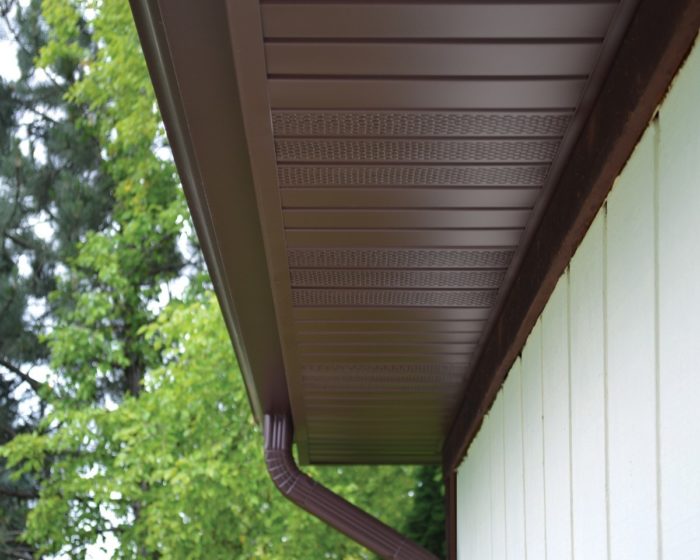Too much paint on your soffits can be a bad thing for your attic and home

Proper attic ventilation in your home is important for many reasons. During the warmer months, heat builds up in your attic during the day and results in higher energy costs for cooling the home. Also, moisture within the home may move into the attic and if this moisture is not properly or effectively removed, it can condense and cause insulation and construction materials to deteriorate. Thus, temperature and moisture control are the major reasons for providing attic ventilation.
So How Much Ventilation is Enough?
A number of federally sponsored studies are under way to look at ventilation rates and methods. However, several studies previously made can help with this decision. The maximum ventilation rate is required to remove heat during the summer cooling months. Attics can reach temperatures of 150 to 160 degrees F during a Florida summer day even though the outside air temperature may only be 95 to 97 degrees F. The cooling load for a home air conditioner depends on the difference in temperature between the inside and outside air, and reduction of attic temperatures from 155 degrees to 105 degrees F by providing adequate ventilation will result in a significant reduction in cooling load. In a home with poor ceiling insulation, heat movement through ceilings may account for 30 percent or more of the total cooling cost. With a well-insulated ceiling, this source of heat may account for only 12 to 15 percent of the total cooling cost. Thus, high attic ventilation rates are most important for poorly insulated ceilings. A poorly insulated ceiling is one whose R rating is less than 14 or one with fewer than 4 inches of fiberglass, rockwool or cellulose insulation.
Attic temperature depends on the amount of solar radiation, construction details and the rate of ventilation. Calculations indicate that on a July day in Florida, a ventilation rate of one air change per minute for a typical attic using 95-degree F air will lower the peak attic temperature to about 101 degrees F. Providing half air change per minute will lower the temperature to about 106 degrees F. Thus, the first half change per minute is most effective and a doubling of this rate only achieves about 5 degrees F additional cooling. Studies indicate that further increases in ventilation are not effective in significantly reducing attic temperatures.
Winter attic ventilation must be sufficient to remove moisture vapor moving from the living space to the attic. In general, ventilation adequate for summer cooling is more than adequate for winter ventilation. Winter rates need not be more than about a tenth of the summer rate.
I’m Not an Engineer, How Do I Make the Calculation?
Here’s how: For a typical rectangular gable end house, determine the desired attic air change volume by multiplying the attic height (ceiling to ridge) by the length of the ridge and then by the width of the house; and then divide the result by 4. Here’s the formula:
(H x L x W)/4
The result will give you the number of cubic feet of air required to be ventilated per minute (cfm). For a hip roof house, this estimate will be a little higher than necessary but will serve adequately.
How Do I Ventilate My Attic?
Attic ventilation can be accomplished by gravity ventilators, wind assisted ventilators or power 77attic for proper temperature and moisture control. Natural ventilation is the most common and energy-efficient method of achieving attic temperature and moisture control. This method takes advantage of two principles. First, most of us know that hot air rises as it becomes less dense. Second, wind movement over and around a home creates areas of high and low pressure. If a space has high air outlets in conjunction with low inlets, ventilation occurs as the air within the space is heated. The greater the vertical distance between the outlet and inlet, the greater the ventilation rate will be. Thus, roof outlets should be at or very near the ridge, and inlets should be under the roof overhang (also known as the soffit or eave).
Ventilation caused by wind pressure differences requires less vent area to achieve the same ventilation rate as ventilation by gravity (convection). One problem with wind ventilation is that the areas of high and low pressure change with wind direction, causing difficulty in locating inlets and outlets so that ventilation will take place regardless of wind direction. The best system is one in which the outlet is near the ridge and the inlets are in the soffit area. The hip roof is best suited to this system, since there is soffit area on all sides of the house. Outlet vents can be provided by roof louvers, gable end louvers, turbine ventilators or continuous ridge vents. These should be constructed so that rain and snow cannot enter. Water leakage is more likely with the turbine ventilator and gable end louver than with fixed roof or ridge ventilators.
Inlet vents may be of the manufactured type, either slotted or perforated, and installed as individual units or in a continuous strip. The slotted opening seems to resist clogging by fibers and dust (and paint) better than the perforated opening. Screen wire is sometimes used for soffit vents, but again clogging is a problem. In some localities frequent cleaning may be necessary with either type.
Providing for Adequate Natural Ventilation
Natural ventilation caused by a chimney effect (convection) or by wind movement is the most economical ventilation method. The quantity of ventilation air depends on opening size, temperature rise and wind movement. Tests have shown that effective natural ventilation can be achieved by providing inlet and outlet open vent areas of approximately 1 square inch per square foot of attic area, when roof slopes of 3/12 to 5/12 are used. This vent area should be the net open area rather than gross vent size. This is sometimes also referred to as “free area”. Some prefabricated vent materials may have only 60 percent net open area. Thus; if a vent area of 10.4 square feet is required, the gross vent area would be 10.4 / 0.6 = 17.3 square feet. The open vent area calculated by these formulas should be divided roughly equally between inlet and outlet.
Example:
Suppose a 1,500-square-foot home requires the above soffit vent area. If the total soffit length of the home is 100 feet, the vent width for a continuous soffit vent would be (17.3 x 12) / 100 = 2.1 inches. Ventilators should be purchased on the basis of net ventilation opening (free air).
Roof overhangs of 12 inches or more provide ample space for inlet (soffit) vents. Outlet vents should have the same net area as inlet vents. This is easily provided by continuous ridge vents or individual roof vents for gable-roofed homes. The roof ridge length may not be long enough on a hip roof to use a continuous ridge ventilator. In this case, several individual roof vents, well spaced near the ridge, should be used.
What About Power Ventilation?
Power ventilation can be accomplished in two ways. In homes not mechanically cooled (air conditioned) the temperature can be controlled to some extent by the use of attic fans. These fans are usually ceiling mounted in a central hallway so that outside air is pulled through open windows and exhausted through the attic. Sufficient outlets must be installed in the attic to exhaust the air without creating high pressures against which the fan must operate. The net area of attic outlets should be 1/800th of the rated fan volume in cfm and 1/8 inch static pressure. The outlets should be distributed uniformly.
Air conditioned homes can use power attic ventilators by installing an exhaust fan through the roof or in the gable. Inlets for the ventilating air should be at the soffit, or the opposite gable, when no roof overhang exists.
Power ventilators have the advantage of providing good ventilation even when there is no wind. They also provide limited attic temperature control when installed in conjunction with a thermostat. For well-insulated ceilings (i.e. insulation levels of R-19 or above) it is doubtful that power ventilation can be justified economically. However, there are some attics which cannot be ventilated by gravity or wind-assisted methods, and in these the power vent is necessary for moisture and temperature control.
